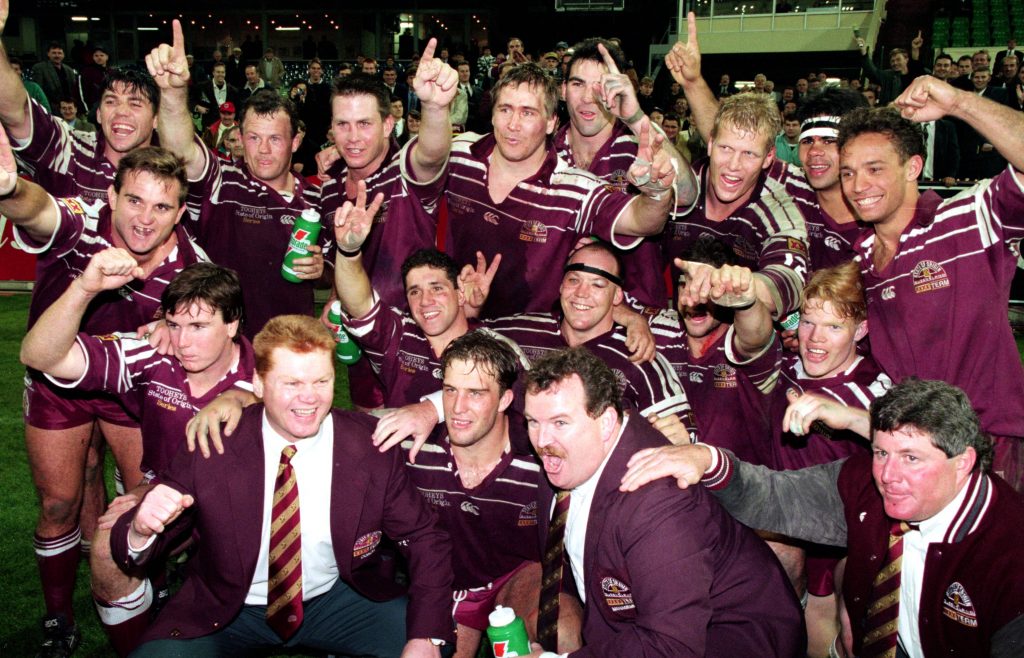The Origin Story Behind NRL’s State Of Origin
It’s mate vs mate and state vs state because State of Origin is back.
For NRL fans it’s the best time of year with some of the finest players in the game assembling to defend their home state and put it all on the line over the three huge nights of footy.
State of Origin is one of the most emotionally charged and demanding games a player can take part in, and for good reason.
It’s known as Australia’s greatest sporting rivalry and for players and fans alike it means a lot to bring home the shield to its rightful state.

(State Of Origin at Telstra Stadium in Sydney 2004. Source: Getty)
Funnily calls for an interstate battle was on the cards well before the schism between league and union even took place, and the first interstate battle between Queensland and New South Wales actually took place way back in 1908 when New South Wales rinsed Queensland 43 – nill.
That first game between the two states kicked off a battle that’s taken place for over a century, with friends going head-to-head determined by the state borderline of New South Wales and Queensland.
But the State of Origin we know today almost didn’t exist because in the 1970s the excitement and relevance of interstate matches pretty much disappeared.
This was mostly due to Queensland players being signed to teams in New South Wales which meant they weren’t eligible for Queensland selection and essentially couldn’t play.
The games were also played mid-week to not clash with the regular comp, and this meant small crowds would trickle down to the suburban Sydney ovals for the game.
Interstate footy really plummeted to its pit in 1977 when the New South Wales League wouldn’t even host the Queensland team.
But then a monumental vibe shift happened, which can be summed up by Brisbane Courier-Mail reporter Hugh Lunn who reportedly said “you can take the Queenslander out of Queensland but you can’t take the Queensland out of the Queenslander.”

(State Of Origin at Melbourne Cricket Ground 1995. Source: Getty)
So in 1980 the battle lines were drawn and two games were played in Sydney to small crowds which resulted in big victories for New South Wales.
However the third game was announced as a ‘state of origin’ match meaning players who were signed to New South Wales clubs could now play for Queensland.
This game would be played in Brisbane and there was excitement brewing around the state in the lead up to the game.
No one thought the Queensland team would get up, or expected the stadium to sell out to a crowd of fans ecstatic to see their heroes playing for their home state for the first time.
The outcome sent shockwaves around the nation with an electric game that saw the Maroons beat the Blues 20 to 10.
This game was pivotal for what it championed for the future of State of Origin and inspired a generation of players like Gorden Tallis.
Tallis played 17 Origin matches for Queensland from 1994 to 2006 and told the NRL that he remembers watching the iconic Brisbane game in 1980.
“I was 7 when the first game was played and I remember just sitting on the couch with Mum and Dad, we were allowed to stay up because Queensland were playing and we were having a hot milo,” said Tallis.
“Just watching the pride in the family’s eyes, especially Dad’s eyes, when all the Queenslanders came home to play, that’s my first memory.”
This match was the birth of the State of Origin we know today and from 1982 the three game origin series was introduced.
The clash has now been played for over four decades and sometimes the difference between winning and losing comes down to mere minutes of sensational footy with plays appearing out of thin-air.
State of Origin is truly the pinnacle of rugby league and with this year’s series kicking off on Wednesday the rivalry, excitement and passion for the game feels just as strong as it did back in 1980.

